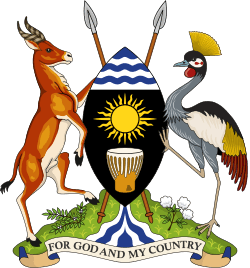Uganda People's Defence Force
| Military of Uganda | |
|---|---|
|
Uganda People's Defence Force emblem | |
| Service branches | Land Forces, Air Force, Special Operations Command[1] |
| Headquarters | Kampala, Uganda[2] |
| Leadership | |
| President | Yoweri Museveni |
| Defence Minister | Adolf Mwesige |
| Chief of Defence Forces | General Katumba Wamala (from 23 May 2013) |
| Manpower | |
| Military age | 18 years of age |
| Active personnel | 45,000 (IISS) ; 2,000 (World Bank 2010)[3] |
| Expenditures | |
| Budget | $995 million (2014)[4] |
| Percent of GDP | 2.85% (2014) |
| Industry | |
| Foreign suppliers |
|
| Related articles | |
| History |
Military history of Uganda: Operation Entebbe Uganda–Tanzania War Ugandan Bush War Lord's Resistance Army insurgency First Congo War Second Congo War Six-Day War (2000) War in Somalia (2006–2009) South Sudanese Civil War |
The Uganda People’s Defence Force (UPDF), previously the National Resistance Army, is the armed forces of Uganda. From 2007 to 2011, the International Institute for Strategic Studies has estimated the UPDF has a total strength of 40,000–45,000, and consists of Land Forces and an Air Wing.[5]
After Uganda achieved independence in October 1962, British officers retained most high-level military commands. Ugandans in the rank and file claimed this policy blocked promotions and kept their salaries disproportionately low. These complaints eventually destabilized the armed forces, already weakened by ethnic divisions. Each post-independence regime expanded the size of the army, usually by recruiting from among people of one region or ethnic group, and each government employed military force to subdue political unrest.
History
The origins of the present Ugandan armed forces can be traced back to 1902, when the Uganda Battalion of the King's African Rifles was formed. Ugandan soldiers fought as part of the King's African Rifles during the First World War and Second World War. As Uganda moved toward independence, the army stepped up recruitment, and the government increased the use of the army to quell domestic unrest. The army was becoming more closely involved in politics, setting a pattern that continued after independence. In January 1960, for example, troops were deployed to Bugisu and Bukedi districts in the east to quell political violence. In the process, the soldiers killed twelve people, injured several hundred, and arrested more than 1,000. A series of similar clashes occurred between troops and demonstrators, and in March 1962 the government recognized the army's growing domestic importance by transferring control of the military to the Ministry of Home Affairs.
1962–1964
On 9 October 1962, Uganda became independent from the United Kingdom, with 4th Battalion, King's African Rifles, based at Jinja, becoming the Uganda Rifles.[6] The traditional leader of the Baganda, Edward Mutesa, became president of Uganda.[7] Milton Obote, a northerner and longtime opponent of autonomy for the southern kingdoms including Buganda, was prime minister. Mutesa recognized the seriousness of the rank-and-file demands for Africanising the officer corps, but he was more concerned about potential northern domination of the military, a concern that reflected the power struggle between Mutesa and Obote. Mutesa used his political power to protect the interests of his Baganda constituency, and he refused to support demands for Africanization of the officer ranks.
On 1 August 1962, the Uganda Rifles became the Uganda Army.[8] The armed forces more than doubled, from 700 to 1,500, and the government created the 2nd Battalion stationed at the north-eastern town of Moroto on 14 November 1963. Omara-Otunnu wrote in 1987 that "a large number of men had been recruited into the Army to form this new battalion, and ... the new recruits were not given proper training" because the Army was already heavily committed in its various operations.[9]
In January 1964, following a mutiny by Tanganyikan soldiers in protest over their own Africanisation crisis, unrest spread throughout the Uganda Army. On 22 January 1964, soldiers of the 1st Battalion in Jinja mutinied to press their demands for a pay raise and a Ugandan officer corps. They also detained their British officers, several noncommissioned officers, and Minister of Interior Felix Onama, who had arrived in Jinja to represent the government's views to the rank and file. Obote appealed for British military support, hoping to prevent the mutiny from spreading to other parts of the country. About 450 British soldiers from the 2nd Battalion, The Scots Guards and Staffordshire Regiment (elements of the 24th Infantry Brigade) responded. They surrounded the First Battalion barracks at Jinja, seized the armory, and quelled the mutiny. The government responded two days later by dismissing several hundred soldiers from the army, several of whom were subsequently detained.
Although the authorities later released many of the detained soldiers and reinstated some in the army, the mutiny marked a turning point in civil-military relations. The mutiny reinforced the army's political strength. Within weeks of the mutiny, the president's cabinet also approved a military pay raise retroactive to 1 January 1964, more than doubling the salaries of those in private to staff-sergeant ranks. Additionally, the government raised defense allocations by 400 percent. The number of Ugandan officers increased from 18 to 55. Two northerners, Shaban Opolot and Idi Amin Dada, assumed command positions in the Uganda Rifles and later received promotions to Brigadier and commander in chief, and army chief of staff, respectively.
Following the 1964 mutiny, the government remained fearful of internal opposition. Obote moved the army headquarters approximately 87 kilometres (54 mi) from Jinja to Kampala. He also created a secret police force, the General Service Unit (GSU) to bolster security. Most GSU employees guarded government offices in and around Kampala, but some also served in overseas embassies and other locations throughout Uganda. When British training programs ended, Israel started training Uganda's army, air force, and GSU personnel. Several other countries also provided military assistance to Uganda.
Decalo writes that:[10]
... using classic 'divide and rule' tactics, he [Obote] appointed different foreign military missions to each battalion, scrambled operational chains of command, played the police off against the army, encouraged personal infighting between his main military 'proteges' and removed from operational command of troops officers who appeared unreliable or too authoritative."
When Congolese aircraft bombed the West Nile villages of Paidha and Goli on 13 February 1965, President Obote again increased military recruitment and doubled the army's size to more than 4,500. Units established included a third battalion at Mubende, a signals squadron at Jinja, and an antiaircraft detachment.[11] On 1 July 1965, six units were formed: a brigade reconnaissance, an army ordnance depot (seemingly located at Magamaga),[12] a brigade signals squadron training wing, a records office, a pay and pensions office, and a Uganda army workshop.[13]
Tensions rose in the power struggle over control of the government and the army and over the relationship between the army and the Baganda people. Shortly after February 1966, Amin was appointed Chief of the Army and Air Force Staff, while Brigadier Opolot was transferred to the Ministry of Defence as Chief of the Defence Staff. On 24 May 1966, Obote ousted Mutesa, assumed his offices of president and commander in chief, suspended the 1962 constitution, and consolidated his control over the military by eliminating several rivals. In October 1966 Opolot was dismissed from the army and detained under the emergency regulations then in force.
At about the same time, Obote abrogated the constitution, revoked Buganda's autonomous status, and instructed the Army to attack the Kabaka's palace, forcing the Kabaka to flee. Elections were cancelled. Political loyalties rather than military skill became critical amongst both officers and men.[14] Many educated southern officers were court-martialled or dismissed in 1966 and 1967, and ethnicity became the key factor in recruitment and promotions.
1970–present
In 1970, the International Institute for Strategic Studies (IISS) assessed the Ugandan armed forces to consist of 6,700 personnel, constituting an Army of 6,250 with two brigade groups, each of two battalions, plus an independent infantry battalion, with some Ferret armoured cars, and BTR-40 and BTR-152 armoured personnel carriers, plus an air arm of 450 with 12 Fouga Magister armed jet trainers, and seven MiG-15s and MiG-17s.[15]
In January 1971, Amin and his followers within the army seized power in a coup d'état.[16]
Shortly after the expulsion of Asians in 1972, Obote launched a small invasion across the Tanzanian border into south-western Uganda. His small army contingent in 27 trucks set out to capture the southern Ugandan military post at Masaka but instead settled down to await a general uprising against Amin, which did not occur. A planned seizure of the airport at Entebbe by soldiers in an allegedly hijacked East African Airways passenger aircraft was aborted when Obote's pilot blew out the aircraft's tires, causing it to remain in Tanzania. Amin was able to mobilize his more reliable Malire Mechanised Regiment and expel the invaders.
In 1976 during Operation Entebbe, the Israeli military destroyed 12 MiG-21s and three MiG-17s based at Entebbe Airport to prevent pursuit.[17]
In 1977, before the Uganda–Tanzania War, the Ugandan armed forces were reported by IISS as consisting of 20,000 land forces personnel, with two four-battalion brigades and five other battalions of various types, plus a training regiment.[18] There were a total of 35 T-34, T-55, and M-4 Sherman medium tanks. An air arm was 1,000 strong with 21 MiG-21 and 10 MiG-17 combat aircraft. The IISS noted that the Ugandan armed forces collapsed in the face of the Tanzanian onslaught and the serviceable aircraft were removed to Tanzania.
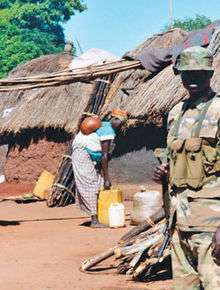
After the Uganda–Tanzania War, fighters available to the new government included only the fewer than 1,000 troops who had fought alongside the Tanzanian People's Defence Force (TPDF) to expel Amin. The army was back to the size of the original army at independence in 1962. Titularly, Colonel Tito Okello served as army commander and Colonel David Oyite Ojok as chief of staff,[19] leading the Uganda National Liberation Army (UNLA).
But in 1979, in an attempt to consolidate support for the future, leaders such as Yoweri Kaguta Museveni and Major General (later Chief of Staff) David Oyite Ojok began to enroll thousands of recruits into what were rapidly becoming their private armies.[7] Museveni's 80 original soldiers grew to 8,000; Ojok's original 600 became 24,000. When then-President Godfrey Binaisa sought to curb the use of these militias, which were harassing and detaining political opponents, he was overthrown in a military coup on 10 May 1980. The coup was engineered by Ojok, Museveni, and others acting under the general direction of Paulo Muwanga, Obote's right-hand man and chair of the Military Commission. The TPDF was still providing necessary security while Uganda's police force—which had been decimated by Amin—was rebuilt, but President Julius Nyerere of Tanzania refused to help Binaisa retain power. Many Ugandans claimed that although Nyerere did not impose his own choice on Uganda, he indirectly facilitated the return to power of his old friend and ally, Obote. In any case, the Military Commission headed by Muwanga effectively governed Uganda during the six months leading up to the national elections of December 1980.
After the Museveni government was formed in 1986, a number of key Rwanda Patriotic Front personnel became part of the National Resistance Army that became Uganda's new national armed forces. Fred Rwigyema was appointed deputy minister of defense and deputy army commander-in-chief, second only to Museveni in the military chain of command for the nation. Paul Kagame was appointed acting chief of military intelligence. Other Tutsi refugees were highly placed: Peter Baingana was head of NRA medical services and Chris Bunyenyezi was the commander of the 306th Brigade.[20] Tutsi refugees formed a disproportionate number of NRA officers for the simple reason that they had joined the rebellion early and thus had accumulated more experience.[20]
Uganda People's Defence Force
The National Resistance Army was renamed the Uganda People's Defence Force following the enactment of the 1995 Constitution of Uganda.
UPDF's primary focus was the conflict with the Lord's Resistance Army (LRA), a rebel group operating in the country's northern region. Since March 2002, UPDF has been granted permission to carry out operations against LRA bases across the border in South Sudan. These raids, collectively known as Operation Iron Fist, have resulted in the repatriation of many abducted children being held by the rebels as child soldiers or sex slaves. The LRA has fled Uganda and been pushed deep into the jungles of the Central African Republic and the Democratic Republic of the Congo (DRC) (principally Orientale Province).
The UPDF has also been the subject of controversy for having a minimum age for service of 13.[21] Many international organizations have condemned this as being military use of children. This has created an image problem for the UPDF and may have impacted the international aid Uganda receives. Western nations have sent a limited level of military aid to Uganda.[22] "Between 1990 and 2002, the army payroll had at least 18,000 ghost soldiers, according to a report by General David Tinyefuza."[23]
The problem continued in 2003, when there was a severe problem of "ghost" soldiers within the UPDF.[24] As of 2008, these personnel problems has been exacerbated by the surge of UPDF troops resigning to work with the Coalition Forces in Iraq.[25] They mostly work as an additional guard force at control points and dining facilities, for example.
Prior to 2000, the United States armed forces trained together with the UPDF as part of the African Crisis Response Initiative. This cooperation was terminated in 2000 because of of Uganda's incursion into the DRC. Following the June 2003 UPDF withdrawal of troops from the DRC, limited nonlethal military assistance has restarted. The UPDF participates in the African Contingency Operations Training and Assistance programme with the United States.
After several interventions in the Congo, the UPDF was involved in a further incursion there, from December 2008 stretching into February 2009, against the LRA in the Garamba area. UPDF special forces and artillery, supported by aircraft, were joined by the DRC's armed forces and elements of the Sudan People's Liberation Army. Called "Operation Lightning Thunder" by the UPDF, it was commanded by Brigadier Patrick Kankiriho, commander of the 3rd Division.[26]
With AMISOM
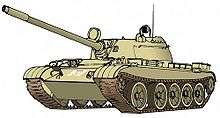
The UPDF has more than 6,200 soldiers serving with the African Union Mission in Somalia (AMISOM).[27] The AMISON force commander is Ugandan Lieutenant General Jonathan Rono.[28]
The force commander in 2009, Ugandan Major General Nathan Mugisha, was wounded in a car bomb attack on 17 September 2009 that left nine soldiers dead, [29] including Burundian Major General Juvenal Niyoyunguruza, the second in command.[30]
The United States has provided extensive training for UPDF contingents headed for Somalia. In the first half of 2012, Force Recon Marines from Special Purpose Marine Air-Ground Task Force 12 (SPMAGTF-12) trained soldiers from the UPDF.[31]
In addition, a significant amount of support to AMISOM has been provided by private companies. "Bancroft Global Development, headquartered on Washington's Embassy Row, employs about 40 South African and European trainers who work with [AMISOM's] Ugandan and Burundian troops."[32] Bancroft director Michael Stock told The EastAfrican that these mentors are embedded with AMISOM units in Mogadishu and southern and central Somalia. They coach commanders on how to predict and defeat the tactics which foreign fighters bring from outside East Africa and teach to al-Shabaab." Bancroft "does not receive funding directly from the US government but is instead paid by AMISOM, which is then reimbursed by the State Department for these outlays." The Associated Press reported that Bancroft has been paid $12.5 million for its work in Somalia since 2008.
On 12 August 2012, two Ugandan Mil Mi-24s flying from Entebbe across Kenya to Somalia crashed in rugged terrain in Kenya. They were found two days later, burned out, with no likely survivors from the 10 Ugandan servicemen on board the two helicopters. Another aircraft from the same flight crashed on Mount Kenya, and all seven Ugandan servicemen on board were rescued a day later. The aircraft were supporting AMISOM in the ongoing Somali Civil War. An accompanying Mil Mi-17 transport helicopter landed without problems in the eastern Kenyan town of Garissa near the Somali border for a scheduled refuelling stop.[33]
In August 2014, the Somali government-led Operation Indian Ocean was launched to clean up the remaining insurgent-held pockets in the countryside, with the AMISOM contingents including the UPDF providing support.[34] On 1 September 2014, a U.S. drone strike carried out as part of the broader mission killed Al-Shabaab leader Moktar Ali Zubeyr.[35] U.S. authorities hailed the raid as a major symbolic and operational loss for Al-Shabaab.[36] According to Pentagon spokesperson Admiral John Kirby, the Ugandan AMISOM forces had informed U.S. intelligence about where Godane and other Al-Shabaab leaders were meeting and provided information on a convoy of vehicles in which he was traveling.[37]
Al-Shabaab subsequently threatened an attack in Uganda for the UPDF contingent's role within AMISOM and the strike on Godane.[38][39] The Ugandan security services, with the assistance of the U.S. military and intelligence, then identified and foiled a major Al-Shabaab terrorist attack in the Ugandan capital Kampala. They recovered suicide vests, other explosives, and small arms and detained Al-Shabaab operatives.[40][41][42]
Land forces
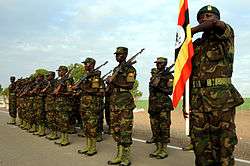
As of June 2013, land forces commander now appears to be Major General David Muhoozi.[43] In 2012, Muhoozi was promoted to the rank of Brigadier General and appointed Commander of the Air Defence Unit in Nakasongola. He previously served as the Brigade Commander for the mechanised brigade in Masaka.[44]
David Muhoozi should not be confused with Brigadier Muhoozi Kainerugaba, the president's son and now head of the Special Forces Command.[1] Previous to his appointment as Commander Defence Forces, General Edward Katumba Wamala served as commander of land forces.[2] General Wamala was among military cadets sent to Monduli Military Academy in Tanzania in 1979 (now the TPDF's Tanzania Military Academy, which Ugandan cadets still attend) and served as Inspector General of Police until 2005. General Wamala succeeded General Aronda Nyakairima as Chief of Defence Force.
In August 2012, Major General Fredrick Mugisha, previously in charge of the African Union Mission in Somalia was appointed as the new Joint Chief of Staff, a position left by Major General Robert Rusoke, the newly appointed Ugandan Ambassador to South Sudan.[45] Brigadier Charles Angina, former General Court Martial Chairperson, was promoted to Major General and appointed Chief of Staff Land Forces.
Army operational organization
The IISS Military Balance 2007 estimates that the land forces include five divisions (each with up to five brigades), one armoured and one artillery brigade. The divisions are as follows:
- 1st Division at Kakiri in Wakiso District
- 2nd Division, HQ Makenke Barracks, Mbarara. Brigadier Peter Elwelu took command in a ceremony on 17 July 2013. He had been appointed in June 2013.[43] In late 2001, soldiers' wives resisted the Chief of Staff Brig. James Kazini's order to quit the barracks. Army spokesman Lt. Col. Phinehas Katirima said, "The army decided to decongest the barracks which was built for about 1,000 soldiers, but now has over 10,000 people."[46]
- 3rd Division (HQ Moroto)
- 4th Division with its headquarters at Gulu,[47] James Kazini served with this division in 1996-99.
- 5th Division at Pader. Created in August 2002.[48] Reported at the time to comprise three brigades, and appears as of 2013 to include 401 Brigade.[49]
Before 2013, the 3rd Division headquarters was reported by afdevinfo to be at Mbale.[50]
The armoured brigade appears to be at Masaka.[51]
The 2nd Division, according to afdevinfo.com, includes the divisional headquarters at Mbarara, the 17th, 69th, 73rd, and 77th Battalions, the Rwenzori Mountain Alpine Brigade, possibly another Alpine brigade, and the 3rd Tank Battalion, and has been heavily involved with border operations since the Congo Civil War began in the 1990s.
Current army equipment
| Origin | Type | Acquired | In service | Notes | |
|---|---|---|---|---|---|
| T-90 | |
Main Battle Tank | 100[52] | 44[52] | T-90S variant; 56 on order.[52] |
| T-54/55 | |
Main Battle Tank | 199[52] | 173[53][54] | |
| T-34 | |
Medium Tank | 10[52] | -- | |
| M4 Sherman | |
Medium Tank | 12[52] | 3[55] | |
| PT-76 | |
Light Tank | 50[52] | 20[53] | |
| BMP-2 | |
Infantry Fighting Vehicle | 31[52] | Sourced from Ukraine.[52] | |
| BTR-80 | |
Armoured Personnel Carrier | 32[52] | BTR-80A.[52] | |
| BTR-60 | |
Armoured Personnel Carrier | 20[53] | 12[56] | |
| BTR-152 | |
Armoured Personnel Carrier | 74[52] | -- | |
| OT-64 SKOT | |
Armoured Personnel Carrier | 36[52] | 4[53] | |
| Mamba | |
MRAP | 40[57] | ||
| RG-31 Nyala | |
MRAP | 15[52] | ||
| Buffel | |
MRAP | 51[52][56] | ||
| Casspir | |
MRAP | 42[52] | For peacekeeping missions.[58] | |
| Eland Mk7 | |
Armoured Car | 40[56] | Eland-90.[59] | |
| Alvis Saladin | |
Armoured Car | 36[60] | -- | |
| Ferret | |
Scout Car | 15[52] | -- | Some sources report up to 60.[53] |
| BRDM-1 | |
Scout Car | 98[52] | -- | |
| BRDM-2 | |
Scout Car | 100[52] | -- | |
| SAMIL | |
Utility Vehicle | 450[61] | ||
| Chubby | |
Mine Detection Vehicle | 1[53] | ||
| D-30 | |
Howitzer | 9[52] | ||
| M-30 | |
Howitzer | 18[52] | -- | Sourced from Libya.[52] |
| Cardom | |
Heavy Mortar | 18[52] | ||
| ATMOS 2000 | |
Self-propelled Howitzer | 6[52] | ||
| BM-21 Grad | |
Multiple Rocket Launcher | 20[52] | ||
| RM-70 | |
Multiple Rocket Launcher | 6[52] | Purchased 2001-2002.[52] |
UPDF Air Wing
There are conflicting reports on what aircraft the Air Wing has in service. Major General Samuel Turyagyenda is the commander.[62] Lieutenant General S. B. Owesigire previously commanded.
In 2011, Emmanuel Tumusiime-Mutebile, the central bank governor, threw the Ugandan shilling into its worst volatility in 17 years, when he told the Financial Times that President Museveni had ignored technical advice to raid Uganda’s meagre foreign exchange reserves to buy new Sukhoi Su-30 fighter aircraft.[63]
Current air force inventory
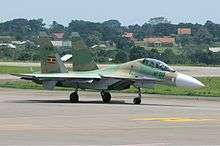
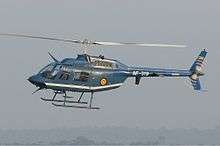
| Aircraft | Origin | Type | Variant | In service | Notes | |
|---|---|---|---|---|---|---|
| Combat Aircraft | ||||||
| MiG-21 | Soviet Union | fighter | 5[64] | |||
| Sukhoi Su-30 | Russia | multirole | Su-30MKK | 8 | 4 on order[64] | |
| Transport | ||||||
| Cessna 208 | United States | utility /surveillance | 2[65] | donated by the U.S.[66] | ||
| Helicopters | ||||||
| Bell 206 | United States | utility | 7[64] | |||
| Huey II | United States | multirole | 5[67] | donated by the US[67] | ||
| Mil Mi-17 | Russia | utility | 10[64] | |||
| Mil Mi-24 | Russia | attack | Mi-35 | 6[68] | ||
| Trainer Aircraft | ||||||
| Aero L-39 | Czech Republic | jet trainer | 6[64] | |||
| SF.260 | Italy | trainer | 4[64] | |||
Paramilitary forces
The IISS Military Balance 2007 says there are 1,800 paramilitary personnel, which include the Marines—Uganda's naval force—with 400 personnel, and eight riverine patrol craft, all of less than 100 tonnes. There is also an 800-strong Uganda Police Force Air Wing with one Bell JetRanger, and a 600-strong Border Defence Unit equipped only with small arms.
The UDPF Marine Wing has 400 personnel, and eight riverine patrol craft, all of less than 100 tonnes. Its main mission is to patrol Lake Victoria and the Nile River. Colonel Micheal Nyarwa is reported as the current commander.
Kadogos
During the late 1980s, Uganda's most tragic military-related problem was the large number of children, mostly orphans, who had attached themselves to the army. The government estimated that there were several thousand kadogos (child soldiers), most of whom were under the age of sixteen. Within days of Museveni's seizing control of the government, his press office announced that kadogos would be disarmed and enrolled in schools designated for that purpose. The first of these, the Mbarara Kadogo School, opened in February 1988, enrolling about 800 pupils between ages five and eighteen, according to the school's commander. An important government aim was to deter these pupils from joining anti-NRA rebel groups still fighting against government control. By 1990 kadogos were no longer evident in regular army units.
Military training establishments
As of February 2011, Uganda maintained the followings military training institutions:[69]
- Bihanga Military Training School – Located at Bihanga, in Ibanda District, Western Region.[70]
- Kalama Armoured Warfare Training School – Located at Kabamba, Mubende District[71][72][73]
- National Leadership Institute – Located at Kyankwanzi, Kyankwanzi District
- Oliver Tambo School of Leadership – Located at Kaweweta, Nakaseke District[74][75]
- Uganda Air Defence and Artillery School – Located at Nakasongola in Nakasongola District
- Uganda Air Force Academy – Located at Nakasongola in Nakasongola District[76]
- University of Military Science and Technology – Located at Lugazi, Buikwe District[77]
- Uganda Junior Command & Staff College – Located at Qaddafi Barracks, Jinja[78]
- Uganda Military Academy – Located at Kabamba, Mubende District
- Uganda Senior Command and Staff College – Located at Kimaka, Jinja
- Uganda Urban Warfare Training School – Located at Singo, Nakaseke District[79]
Notes
- 1 2 Haggai Matsiko, Muhoozi, Independent, 2013
- 1 2 World Defence Almanac 2008, 355.
- ↑ "World Development Indicators and Global Development Finance - Google Public Data Explorer". Google.ro. 2009-07-01. Retrieved 2012-10-28.
- ↑ IISS (14 March 2013). The Military Balance 2013. The International Institute of Strategic Studies (IISS). p. 537. ISBN 978-1-85743-680-8.
- ↑ IISS Military Balance 2007, 297; IISS Military Balance 2011, 447.
- ↑ J.M. Lee, 1969, 40.
- 1 2 Library of Congress Country Studies: Uganda
- ↑ Omara-Otunnu 1987, 52.
- ↑ Omara-Otunnu, 1987, 54.
- ↑ Herbert Howe, Ambiguous Order: Military Forces in African States, 2005, 50, citing Samuel Decalo. Coups and Army Rule in Africa, Yale University Press (1990). ISBN 0-300-04045-8, p.205
- ↑ Library of Congress
- ↑ Tony Avirgan and Martha Honey, War in Uganda, Zed Press, London, UK, 1982, 31.
- ↑ Amii Omara-Otunnu, Politics and the Military in Uganda 1890–1985, St. Martin's Press, New York, 1987, 72
- ↑ E.A. Brett, "Neutralising the Use of Force in Uganda", Journal of Modern African Studies, Vol. 33, No. 1 (Mar., 1995), 136.
- ↑ IISS Military Balance 1970–71, p. 53
- ↑ Omara-Otunnu, 1987, 98.
- ↑ "The East African - Fallout over raid on Entebbe". Retrieved 26 Jan 2013.
- ↑ IISS Military Balance 1979–80, p.55
- ↑ Smith, George Ivan (1980). Ghosts of Kampala. New York: St. Martin's Press. p. 14. ISBN 0-312-32662-9.
- 1 2 Mahmood Mamdani, When Victims Become Killers: Colonialism, Nativism, and the Genocide in Rwanda, Princeton University Press, 2001, ISBN 0-691-10280-5, pp. 172–173
- ↑ CIA World Factbook, , March 2012
- ↑ Uganda: Child soldiers at centre of mounting humanitarian crisis Archived 5 May 2009 at the Wayback Machine.
- ↑ Joshua Kato, "Assessing the cost of an army", Sunday Vision, 30 June 2006 Archived 7 February 2012 at the Wayback Machine.
- ↑ The Weekly Observer, Committee wants death penalty for ghost creators, 2005
- ↑ Iraq Ugandan Guards Face Abuse, accessed December 2008 Archived 19 December 2014 at the Wayback Machine.
- ↑ Monitor (Kampala), UPDF commanders behind Operation Lightening Thunder, 20 December 2008, and Bantariza moved in new UPDF reshuffle, February 2009 Archived 18 April 2009 at the Wayback Machine.
- ↑ "Uganda - UPDF". AMISOM. Retrieved 2 October 2016.
- ↑ AMISON Military Component, AMISON, accessed 2 October 2016
- ↑ http://allafrica.com/stories/200909180007.html
- ↑ Le Visionnaire. "LE VISIONNAIRE: Le Major General Juvenal Niyoyunguruza trouve la mort en Somalie". Retrieved 30 January 2015.
- ↑ Nick Turse, The Election Year Outsourcing No One's Talking About: The U.S. Fighting Proxy Wars Around the Globe TomDespatch.com/Alternet.org, 13 August 2012
- ↑ Kevin J. Kelley, Somalia: How 'Quiet Americans' Helped Defeat Al Shabaab, Garoweonline.com, Aug 22, 2011.
- ↑ Burnt wreckage of two Ugandan army helicopters found, Agence France-Presse via SpaceWar.com, 14 October 2012, accessed 15 August 2012
- ↑ "SOMALIA: President says Godane is dead, now is the chance for the members of al-Shabaab to embrace peace". Raxanreeb. 5 September 2014. Retrieved 6 September 2014.
- ↑ "Pentagon Confirms Death of Somalia Terror Leader". Associated Press. 5 September 2014. Retrieved 6 September 2014.
- ↑ "US confirms death of Somalia terror group leader". Associated Press. 5 September 2014. Archived from the original on 6 September 2014. Retrieved 6 September 2014.
- ↑ "allAfrica.com: Uganda: More Information Emerges On How Intelligence From Uganda Forces Led to the Killing of Alshabaab Leader". allAfrica.com. 18 September 2014. Retrieved 30 January 2015.
- ↑ "Uganda gave US crucial intel on Al Shabaab leader". 6 September 2014. Retrieved 30 January 2015.
- ↑ "Somali militants threaten U.S. attacks to avenge leader's death". Reuters. 9 September 2014. Retrieved 30 January 2015.
- ↑ Nicholas Bariyo (15 September 2014). "Uganda Forces Discover Suicide Vests, Explosives at Suspected Terrorist Cell". WSJ. Retrieved 30 January 2015.
- ↑ "UGANDAN POLICE SEIZE EXPLOSIVES, SUICIDE VESTS FROM SUSPECTED AL SHABAAB CELL", Newsweek, 14 August 2014, accessed 2 October 2016
- ↑ "Uganda seizes explosives, suicide vests from suspected terrorist cell in capital of Kampala". ABC News. 14 September 2014. Retrieved 30 January 2015.
- 1 2 Fred Turyakira, Kampala, Elwelu appointed new 2nd Division UPDF commander, New Vision, 20 July 2013.
- ↑ "Uganda - Africa Center for Strategic Studies". Retrieved 30 January 2015.
- ↑ Uganda Radio Network, 27 August 2012
- ↑ Emmy Allio, Uganda: Makenke Barracks Too Full, New Vision, 19 October 2001.
- ↑ The Official Website: State House, Republic of Uganda Archived 5 May 2009 at the Wayback Machine.
- ↑ Alex B. Atuhaire, 'Uganda: Museveni Creates UPDF 5th Division,' New Vision, 7 August 2002.
- ↑ Columbus Tusiime. "Security Operative on the Run for Robbery". Uganda Radio Network. Retrieved 30 January 2015.
- ↑ 3rd Division Mbale – Uganda
- ↑ The Republic Of Uganda Ministry Of Defence Official Website
- 1 2 3 4 5 6 7 8 9 10 11 12 13 14 15 16 17 18 19 20 21 22 23 24 25 26 27 "Trade Registers". Armstrade.sipri.org. Retrieved 2014-11-20.
- 1 2 3 4 5 6 "Uganda Security Information". Institute for Security Studies Africa. Retrieved 2014-12-01.
- ↑ Taking into account those apparently retired from service at the time of the ISS figures, generated 1999.
- ↑ Copley, Gregory. Defense & Foreign Affairs Handbook 1999. p. 821.
- 1 2 3 "Scramble for the Congo - Anatomy of an Ugly War" (PDF). ICG Africa. 2000-12-20. Retrieved 2013-06-18.
- ↑ "Ugandan army refurbishing APCs". defenceweb.co.za. 2014-08-28. Retrieved 2014-12-01.
- ↑ UPDF peace Keepers return from Somalia. 19 June 2010.
"We went [to Somalia] with Mambas, now we have graduated to Casspirs", Lt. Gen. Katumba Wamala - Ugandan Commander, Land Forces
- ↑ Camp, Steve; Helmoed-Römer, Heitman (November 2014). Surviving the Ride: A pictorial history of South African Manufactured Mine-Protected vehicles. Pinetown: 30 Degrees South. p. 239. ISBN 978-1928211-17-4.
- ↑ "Uganda: How the West brought Idi Amin to power". Retrieved 30 January 2015.
- ↑ "SANDF gets rid of surplus". South African Associated Press. 2005-10-04. Retrieved 2014-07-20.
- ↑ The Independent, Muhoozi, Friday 15 February 2013.
- ↑ New Russian-built jet fighters arrive, The Monitor, Wednesday 13 July 2011.
- 1 2 3 4 5 6 "World Air Forces 2015 pg. 31". Flightglobal Insight. 2015. Retrieved 11 June 2015.
- ↑ "US donates two Cessna 208's to Uganda". Air Forces Monthly. Key Publishing: 26. June 2015.
- ↑ DefenceWeb (17 March 2015). "US donates two Cessna 208B Caravans to Uganda". South Africa: defenceweb.co.za. Retrieved 20 September 2015.
- 1 2 Mufumba, Isaac (29 September 2016). "US explains Shs265b combat helicopters' aid to Uganda". Daily Monitor. Kampala. Retrieved 29 September 2016.
- ↑ "World Air Forces 2015 pg. 11". Flightglobal Insight. 2015. Retrieved 26 December 2014.
- ↑ "Army to start maritime operations". Retrieved 30 January 2015.
- ↑ "1000 TFG Somali soldiers passed out at Bihanga military training School". Retrieved 30 January 2015.
- ↑ Kalama Warfare Training School Opened in 2005 at Kabamba
- ↑ "Museveni shakes up top army command". Retrieved 30 January 2015.
- ↑ "President passes out UPDF tank crew". Retrieved 30 January 2015.
- ↑ Oliver Tambo Leadership School Located at Kaweweta, Nakaseke District Archived 29 September 2011 at the Wayback Machine.
- ↑ South Africa Donates Equipment to Oliver Tambo School Archived 2 November 2012 at the Wayback Machine.
- ↑ About Uganda Airforce Academy
- ↑ The UMST Located at Lugazi Archived 2 November 2012 at the Wayback Machine.
- ↑ Uganda Junior Staff College Commissioned In 2006
- ↑ "1,800 more UPDF sent to Somalia". Retrieved 30 January 2015.
References
| Wikimedia Commons has media related to Army of Uganda. |
- "World Defence Almanac". Military Technology. Bonn, Germany: Monch Publishing Group. XXXII (1): 335. ISSN 0722-3226.
- Library of Congress Uganda Country Study (significant sections copied under U.S. copyright law.)
-
 This article incorporates public domain material from the Library of Congress document: Thomas P. Ofcansky (December 1990). Rita M. Byrnes, ed. "Uganda: A country study". Federal Research Division. The First Obote Regime: The Growth of the Military.
This article incorporates public domain material from the Library of Congress document: Thomas P. Ofcansky (December 1990). Rita M. Byrnes, ed. "Uganda: A country study". Federal Research Division. The First Obote Regime: The Growth of the Military. - Amii Omara-Otunnu, Politics and the Military in Uganda 1890-1985, St. Martin's Press, New York, 1987
Further reading
- One way street, Africa Confidential, Volume 41 No 9. Deep rivalries in the Ugandan People’s Defence Forces have been the main reason for the UPDF’s failure to defeat the LRA since the late 1980s.
- Max Delany, and Jeremy Binnie, 'Triple helicopter crash is major blow for Uganda, AMISOM,' Jane's Defence Weekly, 22 August 2013, 10.
- Rune Hjalmar Espeland, and Stina Petersen (2010). The Ugandan army and its war in the North. Forum for Development Studies. 37(2): 193- 215
- Lee, J. M. (1969), African Armies and Civil Order, International Institute for Strategic Studies/Chatto and Windus, 1969, 77, 105.
- Ngoga, Pascal. "Uganda: The National Resistance Army." African guerrillas (1998): 91-106.
- Gerard Prunier, From Genocide to Continental War: the 'Congolese' Conflict and the Crisis of Contemporary Africa, Hurst & Co., London, 2009, ISBN 978-1-85065-523-7 (p. 88, 186, 197)
- "U.S. relies on contractors in Somalia conflict," New York Times, 10 August 2011
- Rocky Williams, "National defence reform and the African Union." SIPRI Yearbook 2004: 231-249.

